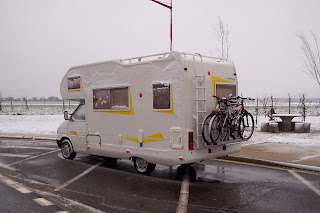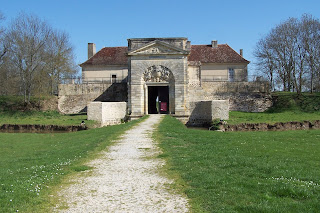Saint-Malo
17-18 March 2007
From Noirmoutier we headed north and inland past Rennes and on to historic Saint-Malo, the walled city on the English Channel from which Jacques Cartier sailed in 1565 to “discover” Canada. Depending on one’s definition of “Canada” and of “discover” this statement is more or less accurate if we assume that we are talking of Canada prior to Newfoundland’s joining Confederation in 1949 and provided that “discover” means discovery by the first Europeans to sight continental Canada. Even that might be questioned based on the possibility that the Norse or Icelanders landed somewhere on continental Canada in addition to their settlement at l’Anse aux Meadows in Newfoundland.
 Historical debates aside, St.-Malo, the City of Corsairs (privateers) is an interesting site. The city’s name is derived from the Welsh monk Mac Low, who in the 6th century established his bishopric at Alet near the rock where the walled city now stands.
Historical debates aside, St.-Malo, the City of Corsairs (privateers) is an interesting site. The city’s name is derived from the Welsh monk Mac Low, who in the 6th century established his bishopric at Alet near the rock where the walled city now stands.
Following extensive damage during allied bombardments in 1944 during the Allied invasion of Europe, the walled city and its cathedral were subsequently rebuilt, in the same mould though not as precise replicas of the pre-war period. Some streets were straightened and widened and some buildings altered.
 The tides here are quite dramatic. The extensive launch ramp even has a 90 degree corner leading to a second level.
The tides here are quite dramatic. The extensive launch ramp even has a 90 degree corner leading to a second level.
 The yachts in the foreground have entered a lock carrying them from the ocean to this basin where the water level is constant regardless of the tidal level beyond the locks.
The yachts in the foreground have entered a lock carrying them from the ocean to this basin where the water level is constant regardless of the tidal level beyond the locks.
During the summer these streets are filled with tourists.
The Cathédrale de Saint-Vincent has its roots in the 4th century and some parts of an earlier monastery church are included in the structure. In the 12th and 13th centuries various parts of the Choir and Nave were expanded. In 1422 construction began on the tower of the transept but was only completed in the 18th century some 300 years later. Many other additions and alterations followed over the centuries. But as mentioned above, the Allied invasion of 1944 resulted in extensive damage and the post-war period saw another major rebuilding of the cathedral.
Many other additions and alterations followed over the centuries. But as mentioned above, the Allied invasion of 1944 resulted in extensive damage and the post-war period saw another major rebuilding of the cathedral.

It is during this period that Jacques Cartier’s tomb was unearthed and relocated.
The cathedral floor boasts a memorial (created as a souvenir of the 1891 visit of the Prime Minister of Québec) of Jacques Cartier kneeling to receive the blessing of the bishop prior to his sailing for North America to “discover Canada” in 1535.
Politics aside Saint-Malo is an interesting historic site with its extensive fortifications both in the walled city and in the harbour.
While the 90 km/hour wind is not evident in the picture one big raindrop can be seen above the fort. With more of the same weather predicted for the next week, we decided to end our rambles around France, bypass Mont-Saint-Michel and Dunkerke and head straight for Belgium.
From Noirmoutier we headed north and inland past Rennes and on to historic Saint-Malo, the walled city on the English Channel from which Jacques Cartier sailed in 1565 to “discover” Canada. Depending on one’s definition of “Canada” and of “discover” this statement is more or less accurate if we assume that we are talking of Canada prior to Newfoundland’s joining Confederation in 1949 and provided that “discover” means discovery by the first Europeans to sight continental Canada. Even that might be questioned based on the possibility that the Norse or Icelanders landed somewhere on continental Canada in addition to their settlement at l’Anse aux Meadows in Newfoundland.
 Historical debates aside, St.-Malo, the City of Corsairs (privateers) is an interesting site. The city’s name is derived from the Welsh monk Mac Low, who in the 6th century established his bishopric at Alet near the rock where the walled city now stands.
Historical debates aside, St.-Malo, the City of Corsairs (privateers) is an interesting site. The city’s name is derived from the Welsh monk Mac Low, who in the 6th century established his bishopric at Alet near the rock where the walled city now stands.Following extensive damage during allied bombardments in 1944 during the Allied invasion of Europe, the walled city and its cathedral were subsequently rebuilt, in the same mould though not as precise replicas of the pre-war period. Some streets were straightened and widened and some buildings altered.
 The tides here are quite dramatic. The extensive launch ramp even has a 90 degree corner leading to a second level.
The tides here are quite dramatic. The extensive launch ramp even has a 90 degree corner leading to a second level. The yachts in the foreground have entered a lock carrying them from the ocean to this basin where the water level is constant regardless of the tidal level beyond the locks.
The yachts in the foreground have entered a lock carrying them from the ocean to this basin where the water level is constant regardless of the tidal level beyond the locks.
There are 3 gates into the walled city.
During the summer these streets are filled with tourists.
The Cathédrale de Saint-Vincent has its roots in the 4th century and some parts of an earlier monastery church are included in the structure. In the 12th and 13th centuries various parts of the Choir and Nave were expanded. In 1422 construction began on the tower of the transept but was only completed in the 18th century some 300 years later.
 Many other additions and alterations followed over the centuries. But as mentioned above, the Allied invasion of 1944 resulted in extensive damage and the post-war period saw another major rebuilding of the cathedral.
Many other additions and alterations followed over the centuries. But as mentioned above, the Allied invasion of 1944 resulted in extensive damage and the post-war period saw another major rebuilding of the cathedral.
It is during this period that Jacques Cartier’s tomb was unearthed and relocated.
The cathedral floor boasts a memorial (created as a souvenir of the 1891 visit of the Prime Minister of Québec) of Jacques Cartier kneeling to receive the blessing of the bishop prior to his sailing for North America to “discover Canada” in 1535.
Politics aside Saint-Malo is an interesting historic site with its extensive fortifications both in the walled city and in the harbour.

While the 90 km/hour wind is not evident in the picture one big raindrop can be seen above the fort. With more of the same weather predicted for the next week, we decided to end our rambles around France, bypass Mont-Saint-Michel and Dunkerke and head straight for Belgium.
As it worked out our last day in France, the last day of winter, dawned in appropriate fashion. And we had been so smug about our winter without snow!!!













































